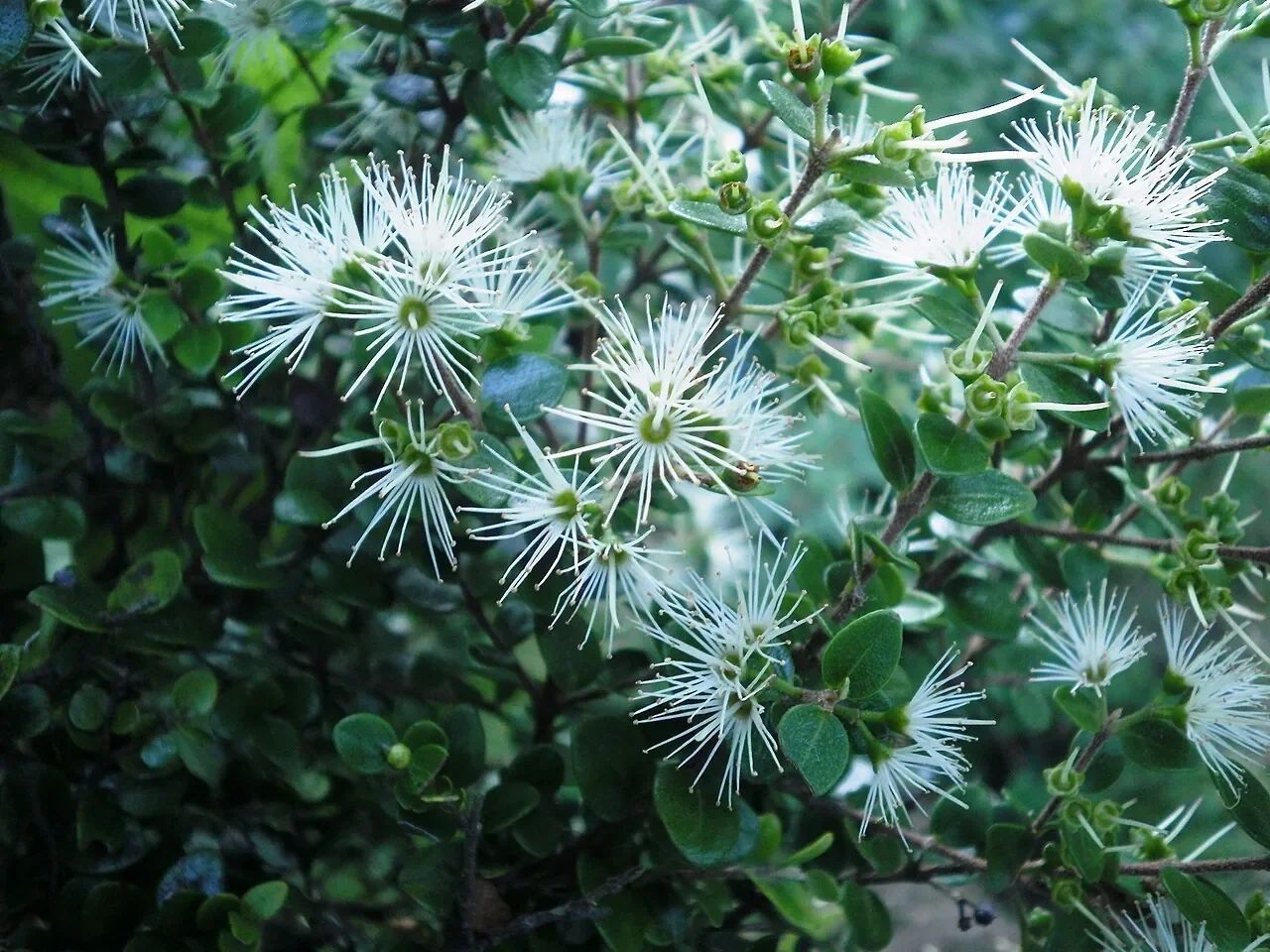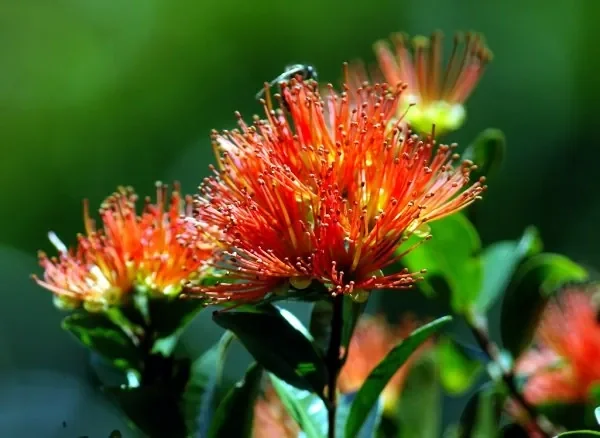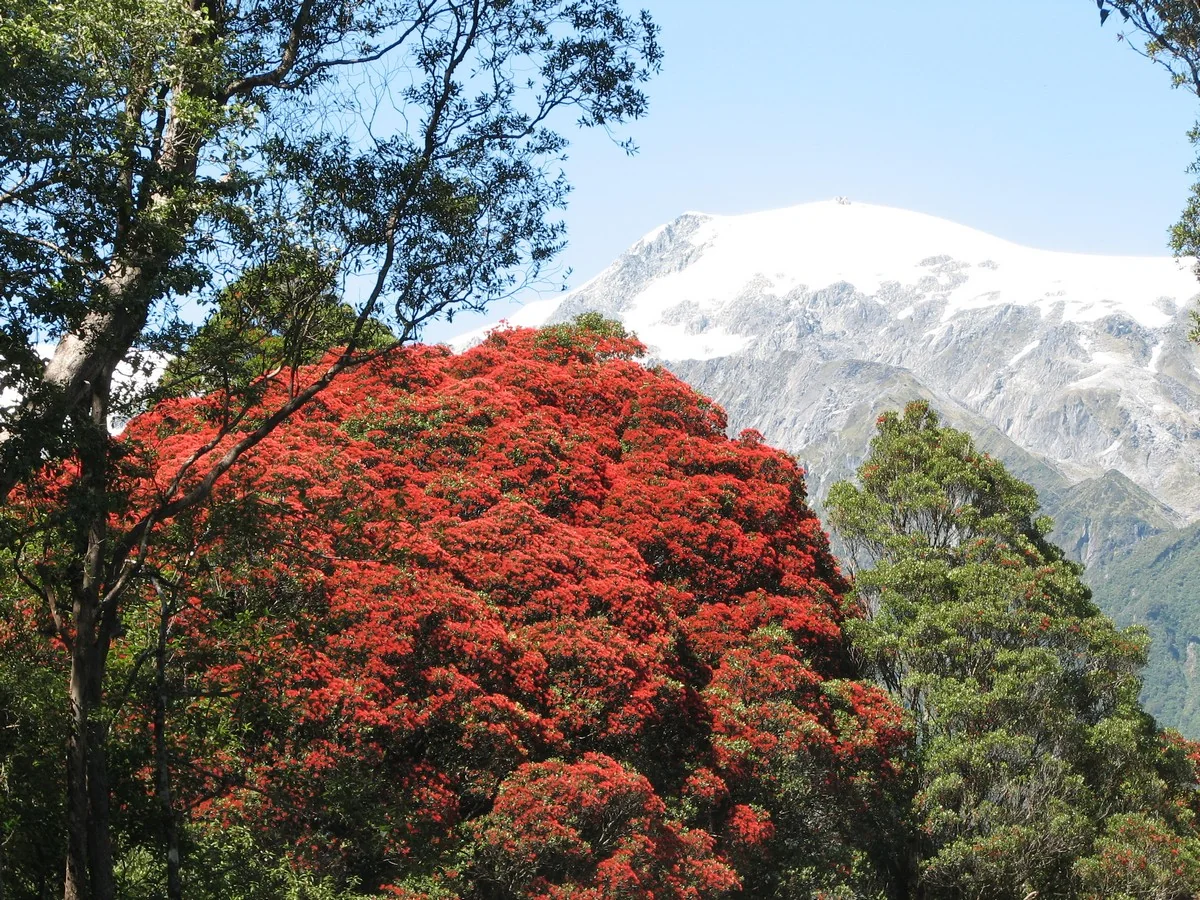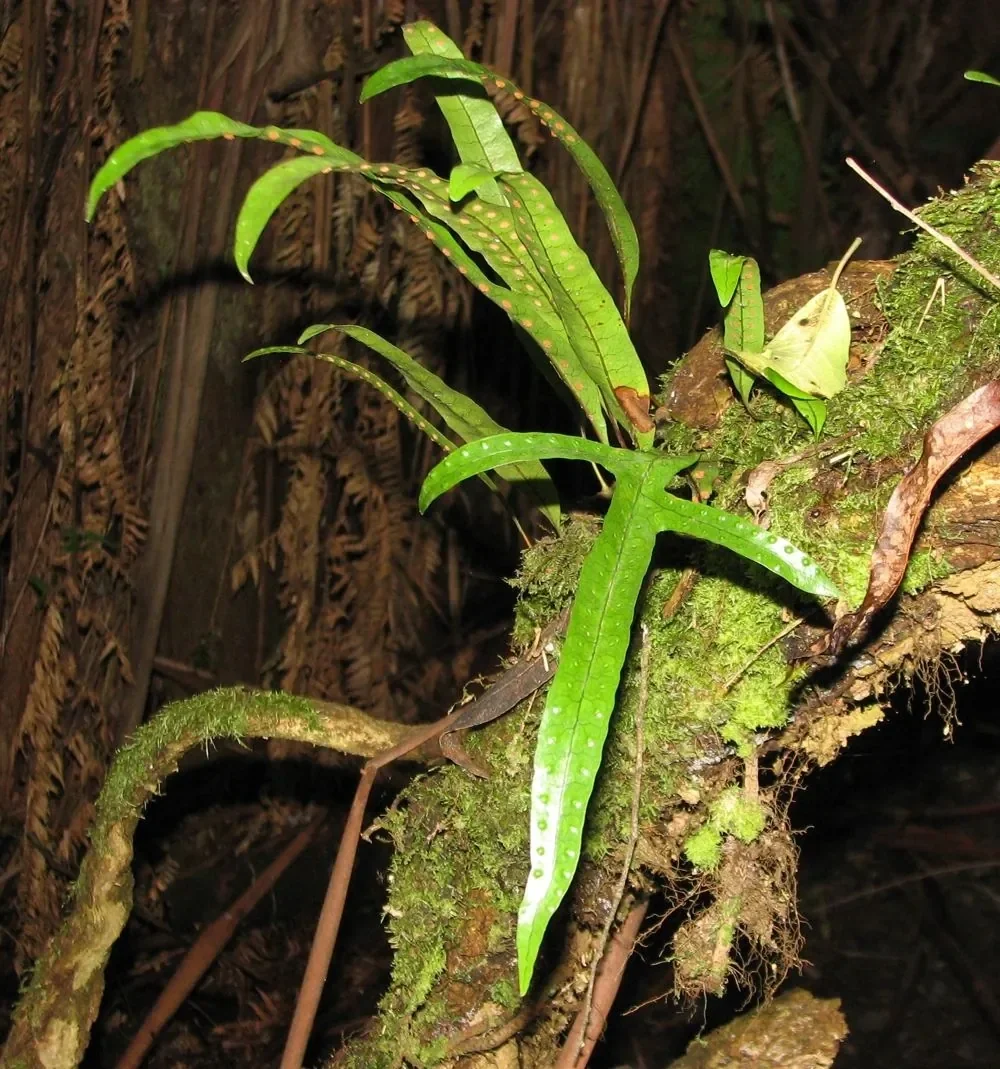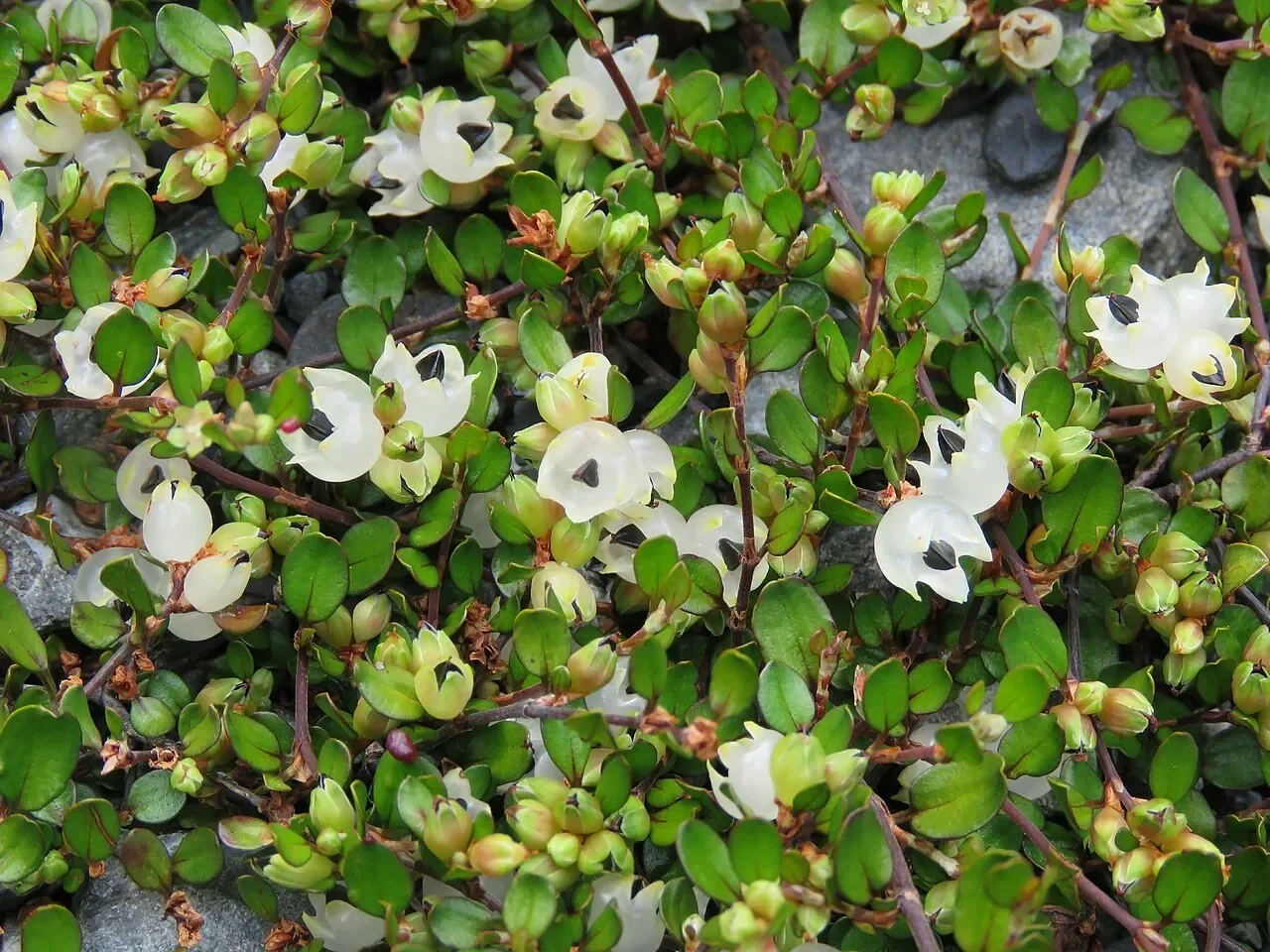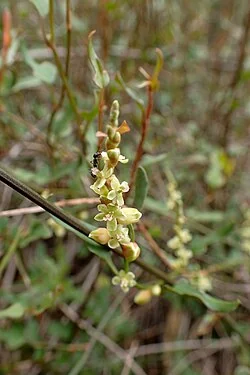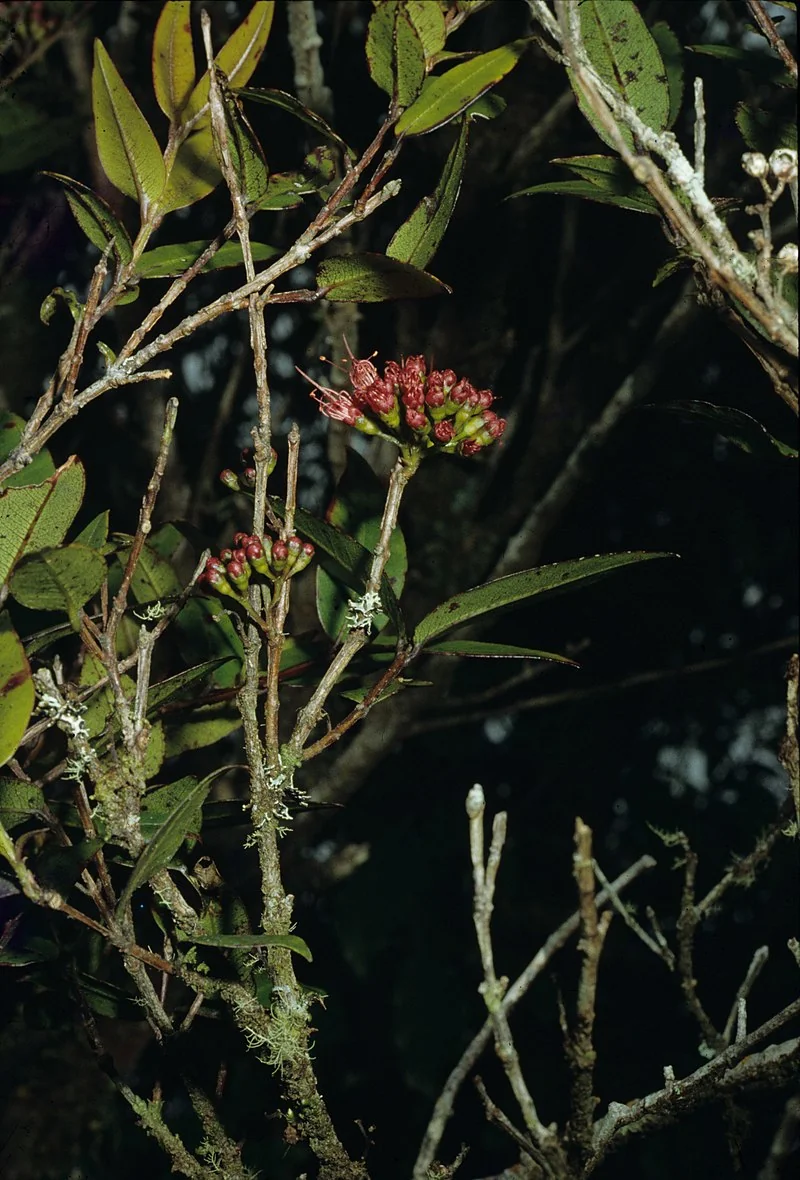
Parkinson's Rata
Metrosideros parkinsonii
This native plant, known as Parkinson's Rata (scientific name: Metrosideros parkinsonii), is a remarkable species endemic to New Zealand. It is characterized by its unique features, ecological role, and cultural significance. This comprehensive guide provides detailed information on its care, propagation, and importance within the New Zealand ecosystem. Understanding this plant contributes to the appreciation of our rich biodiversity and heritage. native trees

Plant Description
Botanical Features
Parkinson's Rata (Metrosideros parkinsonii) is a multi-trunked shrub or small tree endemic to New Zealand, typically growing up to 7-8 meters tall. It is characterized by its straggling, many-branched habit, sometimes featuring aerial roots. The bark is pale grey to brown-grey and flaky. Its branchlets are 4-angled, hairless, and initially red, maturing to brown-grey or grey. The leathery, ovate-lanceolate leaves are arranged in opposite pairs, measuring 25-75 mm long and 15-30 mm wide. They are dark green on the upper surface, paler beneath, and often show red blistering or blemishes, with slightly rolled-under margins. A striking feature is its crimson, fluffy flowers, which are borne directly on the stems (cauliflorous), often below the main vegetative branches. These flowers typically appear in clusters of up to eight, with prominent stamens that are much longer than the petals. The primary flowering season spans from spring to early summer, or specifically November to January. The plant produces dry, ribbed capsules, 6-8 mm long, that split to release seeds.
Quick Facts
| Scientific Name | Metrosideros parkinsonii |
|---|---|
| Height | 15-20 m |
| Spread | 3-5 m |
| Water Needs | Moderate |
| Light | Full sun to part shade |
| Frost Tolerance | Moderate |
| Salt Tolerance | Moderate |
| Growth Rate | Medium |
| Lifespan | Long |
Climate Best Suited to
Parkinson's Rata (Metrosideros parkinsonii) is primarily found in lowland to hilly forests across the North Island of New Zealand, extending to the Marlborough Sounds in the South Island. It demonstrates good adaptability to various conditions, thriving in areas with well-drained soils and tolerating both full sun and partial shade. Its natural distribution suggests a preference for warmer, more humid environments but with a reasonable tolerance for cooler temperatures found in its southern range.
Regional Suitability
| City | Climate Suitability |
|---|---|
| Whangārei | Ideal |
| Auckland | Ideal |
| Hamilton | Ideal |
| Tauranga | Ideal |
| Rotorua | Ideal |
| Gisborne | Ideal |
| New Plymouth | Ideal |
| Napier | Ideal |
| Whanganui | Ideal |
| Palmerston North | Ideal |
| Wellington | Ideal |
| Nelson | Ideal |
| Christchurch | Ideal |
| Dunedin | Moderate |
| Invercargill | Moderate |
Natural Habitat
Parkinson's Rata is a rare species with a scattered distribution. In the North Island, it is found only on Great Barrier and Little Barrier Islands, where it grows in montane "cloud" forests, often on cliff faces and rock outcrops. In the South Island, it is found on the western side, from Collingwood south to just north of Hokitika, where it grows along ridgelines in peaty ground.
Plant Conservation
Metrosideros parkinsonii, also known as Parkinson's rātā, is a shrub or small tree endemic to New Zealand. Its conservation status was upgraded to 'Threatened - Nationally Vulnerable' in 2017, primarily due to the emergence of myrtle rust in New Zealand. Previously, in 2012, it was not considered threatened. This species is found in specific regions of New Zealand, including Great Barrier Island and Little Barrier Island in the North Island, and the western side of the South Island. Key threats to Metrosideros parkinsonii include myrtle rust (Austropuccinia psidii), introduced possums which feed on the leaves, buds, flowers, and young shoots, and habitat degradation from human activity. Cultivation of Metrosideros parkinsonii is challenging, as established plants can die suddenly, and propagation from cuttings is difficult. Conservation efforts for Metrosideros species in New Zealand are supported by organizations like Project Crimson and the DOC/BGANZ partnership.
Growing Requirements
Soil Requirements
Parkinson's Rata (Metrosideros parkinsonii) is remarkably adaptable to different soil conditions, thriving in well-drained environments. It can tolerate a variety of soil types, from sandy to loamy, and prefers a neutral to slightly acidic pH. Good drainage is crucial to prevent root rot, ensuring healthy growth and development.
- Tolerates a wide range of soil types from clay to sandy
- Prefers well-draining soils but can handle occasional waterlogging
- Thrives in moderately fertile soils but will grow in poor soils too
- Can tolerate slightly acidic to slightly alkaline pH
- Handles coastal conditions including salt spray
Light Requirements
Parkinson's Rata (Metrosideros parkinsonii) thrives in a variety of light conditions, from full sun to partial shade. Optimal growth and flowering are typically achieved in locations receiving ample sunlight throughout the day. However, it can also tolerate some shade, especially in hotter climates, where it benefits from protection during the most intense afternoon sun.
- Full sun for optimal growth and form
- Can tolerate partial shade but may develop a leggier form
- At least 6 hours of direct sunlight daily is ideal
- Northern or eastern exposures work well in garden settings
Water Requirements
Once established, Parkinson's Rata (Metrosideros parkinsonii) is remarkably drought-tolerant, requiring minimal supplemental watering. During its establishment phase, consistent moisture is crucial to encourage strong root development. Mature plants can withstand dry periods, but regular watering during prolonged droughts will promote healthier growth and more abundant flowering.
- Moderate watering during establishment (first 1-2 years)
- Drought-tolerant once established
- Can handle periods of soil saturation
- Reduce watering in winter when growth slows
- Signs of overwatering include yellowing leaves and crown rot
Planting Guide
Site Selection and Habitat Mimicry
- Natural Habitat: This species naturally grows in coastal to montane forests, often along ridgelines in peaty ground, and in semi-shaded sites. In the North Island, it's found in montane "cloud" forest, wind-pruned forest, scrubland, and on cliff margins.
- Light: It seems to do best in a semi-shaded site. While some Metrosideros species prefer full sun to partial shade, avoiding prolonged intense midday sun is generally recommended to prevent leaf scorching.
- Temperature: Metrosideros generally thrives in warm summer temperatures and prefers a cooler winter environment (ideally 5-10°C) to promote flowering. Young plants should be protected from frost.
Soil and Planting
- Soil Type: Metrosideros parkinsonii prefers damp, humus-enriched soil. Generally, Metrosideros species thrive in well-drained, acidic to neutral soil (pH 5.5-7.5) that is rich in organic matter. A good soil mix can include garden soil, sand, and compost, ensuring excellent drainage.
- Drainage: Good drainage is crucial to prevent root rot. Incorporate perlite or coarse sand if needed. For heavier clay soils, consider planting on a raised mound and using gypsum clay breaker.
- Planting: When planting into the ground, dig a hole twice the depth and width of the root ball. Mix compost and sheep pellets into your existing soil. Ensure the top of the plant's roots sits level with the surrounding ground. If planting in containers, use a container mix that aids moisture retention.
Ecological Role
Parkinson's rātā (Metrosideros parkinsonii) contributes nectar, structure, and connectivity in coastal and montane forests, supporting rich pollinator assemblages.
Pollinators and Fruiting
- Nectar-rich blooms: Seasonal flowering feeds insects and nectar-feeding birds, sustaining food webs when other resources are scarce.
- Bird dispersal: Seeds are moved through forest mosaics by birds utilizing flowering and fruiting stands.
Habitat Services
- Canopy complexity: Branching habit and persistent foliage create shelter and perches across forest edges and gullies.
- Epiphytic support: Textured bark and limbs host bryophytes and invertebrates, enriching vertical habitat.
Resilience
- Disturbance tolerance: Responds to canopy gaps by vigorous growth, aiding forest recovery.
- Myrtle rust awareness: As a myrtle, benefits from airflow and diversity to mitigate pathogen pressure.
By fuelling pollinators and enhancing canopy structure, M. parkinsonii elevates biodiversity and ecological stability.
Uses and Significance
Garden Uses
- Specimen tree for visual impact
- Suitable for native gardens and restoration projects
- Enhances native garden aesthetics and biodiversity
- Provides architectural accent with its unique structure
- Effective for erosion control on slopes and banks
Landscaping Ideas
Showcasing Cauliflorous Blooms
- Espalier/fan-train: Train lower limbs on wires to bring stem-borne flowers into view.
- Woodland edges: Plant at the forest margin with plenty of light and shelter from severe frost.
- Mixed native canopy: Combine with Griselinia, Hoheria, and Coprosma for layered texture.
- Containers with frames: Suitable in large tubs with an obelisk in mild climates.
Choose a warm, bright site with free-draining soil. Avoid overfeeding to keep growth compact and floriferous.
Seasonal Care Calendar
Spring
In spring, Parkinson's Rata (Metrosideros parkinsonii) begins its active growth phase. New foliage emerges, and it's an ideal time for planting new specimens or propagating. Ensure adequate moisture and monitor for early signs of pests.
- New growth begins with fresh foliage development
- Apply a balanced, slow-release fertilizer if desired
- Excellent time for planting new specimens or dividing offsets
- Monitor for new pest activity and address promptly
Summer
Summer is the peak growing season for Parkinson's Rata (Metrosideros parkinsonii), often accompanied by flowering. Consistent watering is important, especially for young plants, to support vigorous growth and prevent stress during dry periods.
- Flowering typically occurs in early to mid-summer (November-January)
- Water young trees regularly during extended dry periods
- Avoid heavy pruning during the active growing season
Autumn
During autumn, Parkinson's Rata (Metrosideros parkinsonii) prepares for the cooler months. Fruits or berries develop, providing food for native birds. It's also a good time for planting and general garden cleanup.
- Fruits or berries develop and ripen (December-February), attracting birds
- Natural leaf shedding occurs as part of its growth cycle
- Good time for planting new specimens to establish before winter
- Clean up fallen leaves if a tidy appearance is desired
Winter
Winter is typically a dormant period for Parkinson's Rata (Metrosideros parkinsonii). Minimal care is required, though young plants may benefit from protection in colder regions. This is an opportune time for any necessary structural pruning.
- Generally dormant with minimal growth activity
- No special winter protection needed in most mild climates
- Suitable time for structural pruning if required
- Fallen leaves can be left as mulch or removed for tidiness
When to Prune and How Much
Parkinson's Rata (Metrosideros parkinsonii) generally requires minimal pruning to maintain its natural form and health. Pruning should focus on removing dead or damaged growth and shaping the plant as needed.
- Remove dead, damaged, or diseased branches at any time of year
- Light formative pruning when young helps establish good structure
- To create a multi-trunked specimen, cut the main stem to encourage branching
- Fallen leaves can be removed for a tidier appearance, or left as natural mulch
- If necessary, lower branches can be removed to create clearance underneath
- Major pruning is best done in late winter to early spring before new growth
Always use clean, sharp tools for pruning to minimize the risk of disease and ensure clean cuts. The plant often responds well to pruning with vigorous new growth, contributing to a fuller, healthier appearance.
How to Grow Parkinson's Rata
From Seed
Propagating Parkinson's Rata (Metrosideros parkinsonii) from seed is a rewarding process, though it requires patience. Start by collecting seeds from the ripe capsules in autumn. The fine, dust-like seeds should be sown on the surface of a well-draining seed-raising mix. Do not cover the seeds with soil. Water the tray gently by misting and place it in a warm, sheltered spot with bright, indirect sunlight. Germination can be slow, taking several months. It is crucial to maintain consistent moisture levels without waterlogging the soil. Once the seedlings are large enough to handle, carefully prick them out into individual pots. Use a deep pot to accommodate the plant's developing taproot. Grow them on for a year or two before planting them in their final position.
From Cuttings
Parkinson's Rata can also be grown from semi-hardwood cuttings, which is a faster method than growing from seed and ensures the new plant is true to the parent. Take cuttings in late summer or early autumn from healthy, vigorous shoots of the current season's growth. Cuttings should be about 10-15cm long and taken from a node. Remove the leaves from the lower half of the cutting to reduce water loss and dip the base in a rooting hormone to encourage root development. Insert the cuttings into a container filled with a free-draining potting mix. Place the container in a warm, humid environment, like a propagator or under a clear plastic bag, to maintain high humidity. Keep the mix moist but not waterlogged. Roots should form within a few months. Once the cuttings have a well-developed root system, they can be potted on into larger containers and grown until they are robust enough to be planted out in the garden.
Planting
When planting your Parkinson's Rata, choose a site with well-drained soil and a sunny or partially shaded aspect. While it is adaptable to a range of conditions, it thrives in a cooler, moist root run. Before planting, prepare the site by digging a hole that is twice the width of the root ball and just as deep. Gently tease out the roots of the plant to encourage them to grow outwards into the surrounding soil. Place the plant in the hole, ensuring that it is at the same depth as it was in the pot. Backfill with soil and firm it down gently. Water the plant thoroughly after planting to settle the soil and eliminate any air pockets. It is important to keep the soil moist, especially during dry periods, until the plant is well-established. Applying a layer of organic mulch around the base of the plant will help to retain moisture, suppress weeds, and provide nutrients as it breaks down.
Pests and Diseases
Myrtle Family Health
- Myrtle rust: Inspect new growth; maintain airflow and avoid pruning during humid flushes.
- Scale and sooty mould: Treat with horticultural oil and clean foliage.
- Leafrollers: Remove affected leaves; encourage birds as predators.
- Poor drainage: Ensure well-drained conditions, especially in heavier soils or containers.
Cultural Significance
Metrosideros parkinsonii, also known as Parkinson's rātā or shrubby rātā, is a shrub or small tree endemic to New Zealand. While other Metrosideros species, such as the P� hutukawa (Metrosideros excelsa), hold significant cultural importance for Māori, specific cultural significance for Metrosideros parkinsonii is not extensively detailed in historical records.
The plant was named in honor of Sydney Parkinson, Captain James Cook's botanical artist during his first voyage to New Zealand. Its presence as a unique endemic species contributes to New Zealand's rich biodiversity and natural heritage.
Bonus Tip
Parkinson-s rātā (Metrosideros parkinsonii) flowers directly from the stems (cauliflory). To enjoy blooms at eye level, train a few lower branches horizontally along a fence or espalier - the plant will often flower on these trained limbs as they mature.
